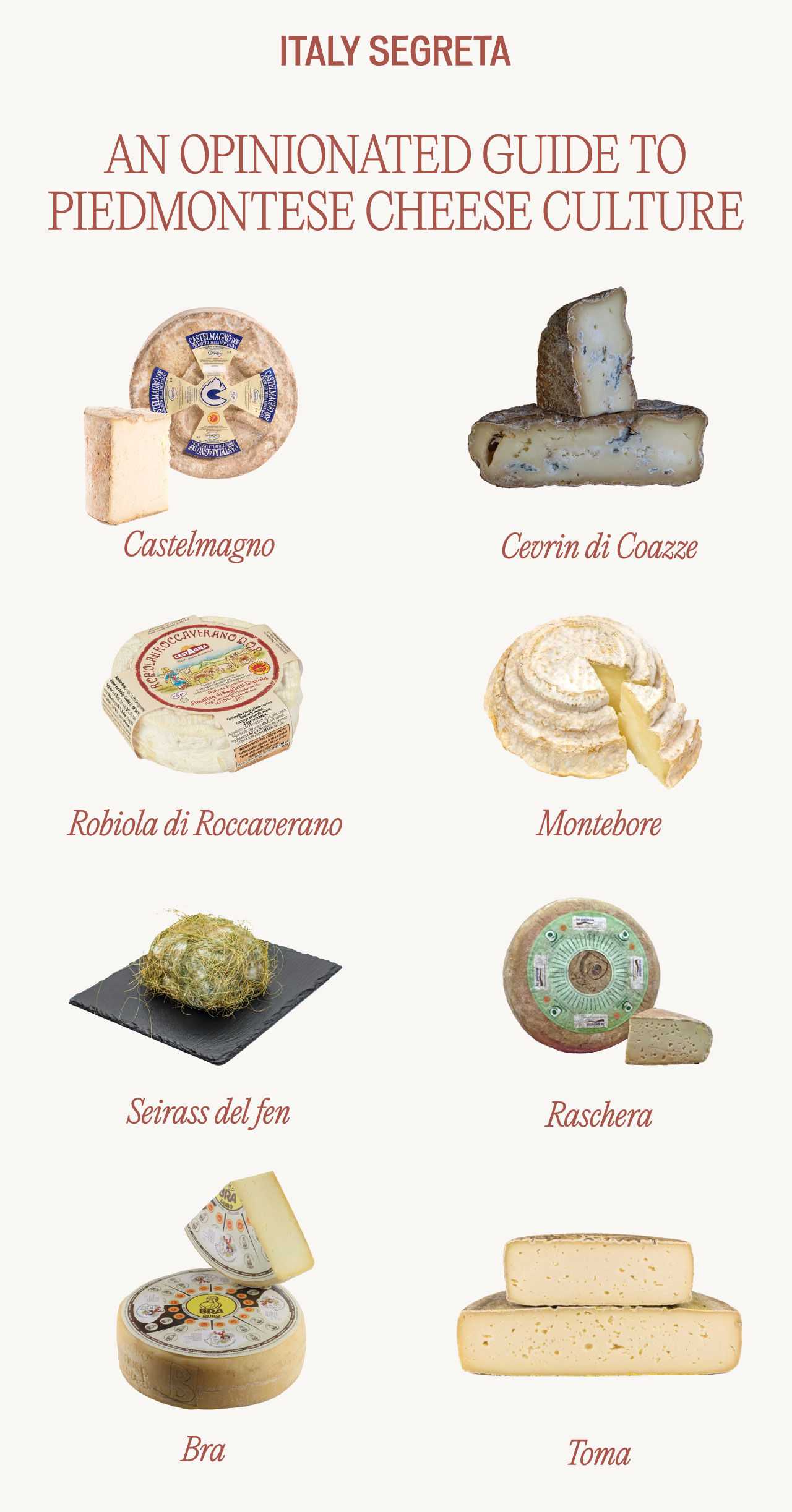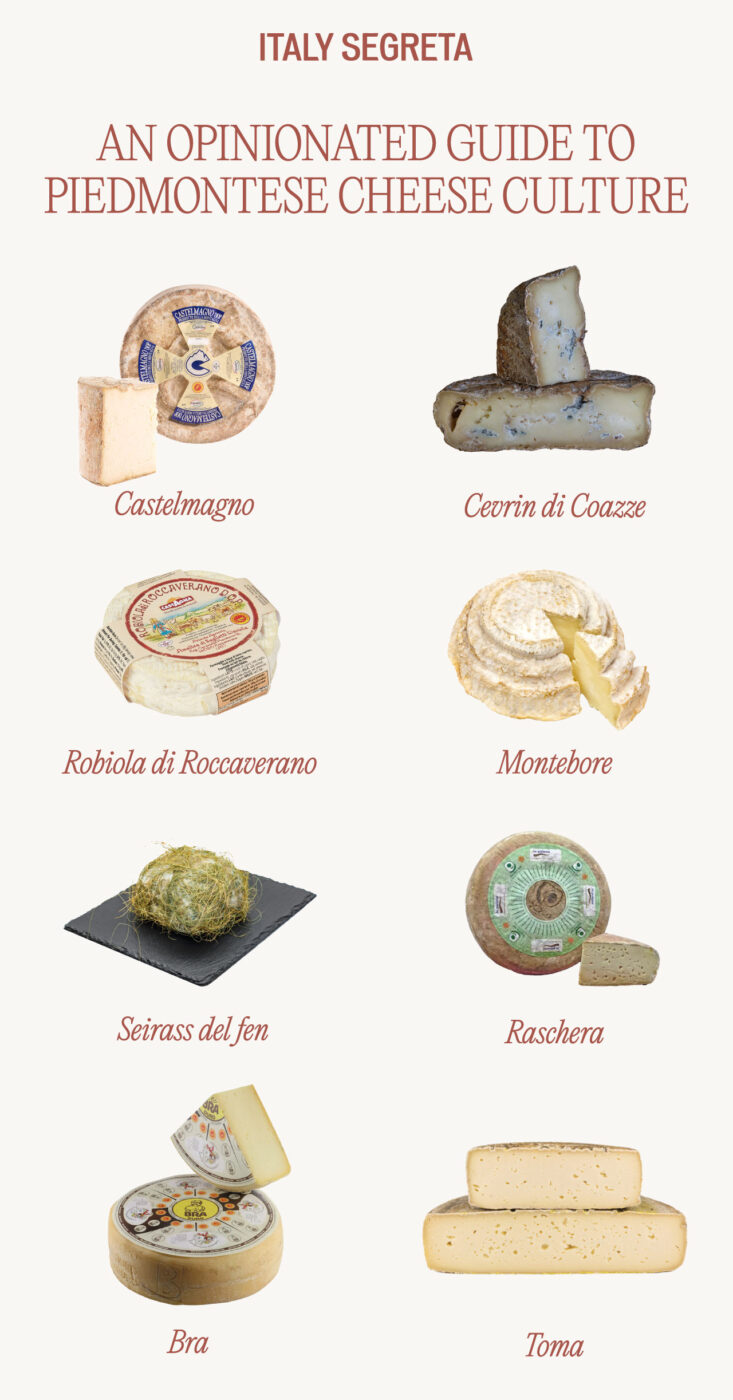For anyone who loves cheese as much as I do, Piedmont is the closest thing to heaven on Italian earth. I do not say this lightly; I am aware of the wealth of cheesemaking excellence found in other regions, from Emilia-Romagna’s Parmigiano Reggiano to Campania’s Mozzarella di Bufala. But hear me out: it is not just a matter of quality, variety, or abundance. What sets Piedmont apart, I believe, is its unique combination of natural and human: a special blend of mountains, pastures, rolling hills, and verdant planes meeting a multifaceted culture combining Alpine, Mediterranean, French, and Occitan elements. Piedmont is, in a word, a special terroir for artisan cheese; it’s the very same terroir that produces the famous red wines or the prized white truffles.
I was surprised, while browsing through Elizabeth David’s Italian Food, which I have often used as a reference, and running my finger along the index to find the page dedicated to cheese, that I did not find much mention of the outstanding range coming from the westernmost Italian region. I suppose this might be linked to Piedmont having been in the peripheral vision of the food-writing expats until recently. Sure enough, through events like Cheese in Bra, the late food-and-wine celebration of the Langhe, the Slow Food Movement, and the University of Gastronomic Sciences in Pollenzo–which spreads the gospel of Piedmontese excellence through its efficient communication and small army of faithful alumni (here’s one!)–things are slowly starting to change. The word is out, and what might have been a best-kept secret is no longer. Either way, we’re here to set the story straight.
Growing up as a cheese worshiper in the making–I have always preferred cheese to dessert, my mother swears; a statement that finds proof in my career choices and remains true to this day–my first serendipitous encounter with Piedmontese cheese happened at the age of seven, during a family trip to Turin, visiting relatives who had relocated there to work at FIAT. During the time we spent at Aunt Paola’s, not only did she prepare multiple courses with new-to-me names like agnolotti del plin and flan di broccoletti, but surprised us with such an elaborate series of cheese dishes that she ignited a flavor revolution within me. It was at her table that I tasted tomini for the first time: palm-sized discs of oozing, pan-grilled cheese encased in a soft, white rind. It was there that I discovered the existence of gnocchi al Raschera, mentally repeating the name–Raschera, Raschera–so as to remember that these thumb-sized potato dumplings swimming in a shallow bath of sweet-savory cheese sauce were now my favorite dish. And it was still at her table that I was introduced to the ritual of the cheese course–a Piedmontese tradition that reveals its French affiliation–as a wooden board with cheeses of different colors, shapes, and textures was placed in the center of the table alongside a bowl of fruits and nuts. I was hooked; I sampled everything with curiosity and eagerness. I remember telling my mother, “Can we do this at home?”
Many happy returns–to her table and to the region–followed that first experience. So, it’s perhaps not a coincidence that when I found myself at a crossroads, having to decide what to do with my life after graduating from college, I was drawn to the idea of studying food–but really, cheese–in Piedmont. The cheese sirens were calling me from a place both distant and familiar. And so I went, all too ready to dive into the rabbit hole that had been alluring me since those early days in Turin. Eventually, I graduated with a thesis in cheese terroir (hence my strong statement a few paragraphs ago) and continued on this journey as I studied, ate in osterie with baroque cheese carts, purchased from market stalls and delis, traveled, and visited farms up and down the mountains and hills, on foot, by car, alone, in groups, all to discover how cheese was made, talk to people, and, most of all, taste, taste it all. I took this quest as if it were my vocation and I were a pilgrim on sacred land.
And so, here is a personal account of impressions and notes. Of the close-to-infinite kinds of cheese produced on Piedmontese soil, many stand out for their cultural and culinary value. I’ve listed eight of the traditional knowledge varieties made in the region, knowing all too well that this selection is dictated as much by personal preference–and by the stories that accompany them–as by relevance. Consider this a compendium of sorts, a my-two-cent guide to keep in your back pocket might you want to do a cheese-led exploration of the region, or just pay a visit to a well-stocked Italian cheesemonger. Many of these cheeses can be enjoyed in their natural form–as a pre-dessert or a dessert, in keeping with local customs; this list would make a perfect selection–but some also double as ingredients in outstanding traditional recipes.
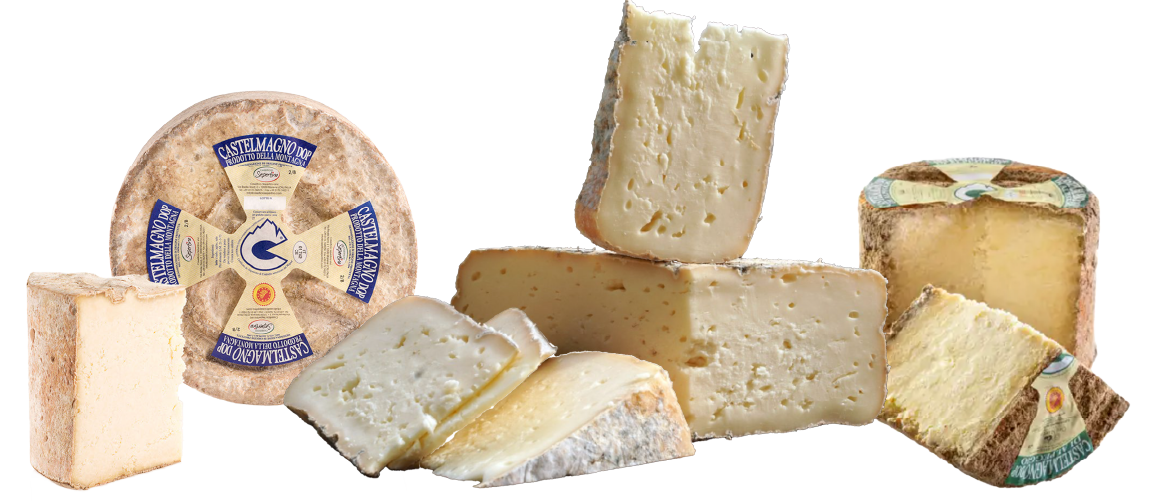
Castelmagno
I could not leave this off the top of the list. My friend Emma, who went on to become a professional cheese consultant, educator, and author–unlike my amateur self–might still remember our mongering days when I complained about the impossibility of finding good Castelmagno–my favorite cheese, inexplicably to her!–in London. What’s so special about it, you might wonder?
Castelmagno is a semi-hard, naturally blue, raw milk cheese of unique complexity and cultural value. A symbol of Piedmont’s Alpine heritage, the earliest known mention of it dates to 1277, when court records state it was required as payment (“Give me cheese wheels, not money!” is a statement I can endorse) to the Marquis of Saluzzo in exchange for use of certain pasture lands in the Grana Valley, in the province of Cuneo. The Grana Valley (don’t let the name mislead you) is a special place indeed. It has Occitan influences and a wealth of biodiverse pastures, full of endemic herbs and flowers that impart exceptional qualities to the milk.
The 19th century marked the golden age of Castelmagno as it became the king of Piedmontese cheeses and appeared on the menus of the most prestigious restaurants in Europe. Then came its decline: with the wars and the depopulation of the mountains, it was at serious risk of disappearing. So in came the DOP in 1982 which, in a way, created confusion between the cheese produced in valley dairies and the cheese produced in the alpine pastures–they are both called Castelmagno. Fortunately, there are still a couple of herders making the original Castelmagno d’alpeggio, processing the milk from their own cows in alpine pastures situated at altitudes above 1,600 meters following time-honored techniques. Given its limited availability and cultural value, Castelmagno d’alpeggio is now listed as a Slow Food Presidium, stressing the difference with other types and supporting the local cheese makers who continue to produce it.
Made primarily with cow’s milk with small additions of sheep or goat milk (from a minimum of 5% to a maximum of 20%), especially when crafted at higher altitudes, Castelmagno has a pungent, persistent, and multi-faceted profile. The production technique involves breaking the curd into minuscule lumps, which are amassed, hung, and cloth-drained. The curd is then broken into small cubes, amassed again, and left to acidify in whey for three to four days before being ground, kneaded with salt, and pressed into molds. Castelmagno is then aged in a natural environment for at least 120 days, though it is known to give its best after about six months.
In its young, milky, ivory-colored form, it is primarily used in cooking, melted to accompany gnocchi or risotto. As a table cheese, it’s served in its aged form, with its characteristically rough, pungent brown rind, tangy, grassy, peppery flavor, crumbly texture, and blue-green veining. Intensely aromatic, it’s exquisite when paired with the local preserve called cognà and a tipple of Barbera wine.
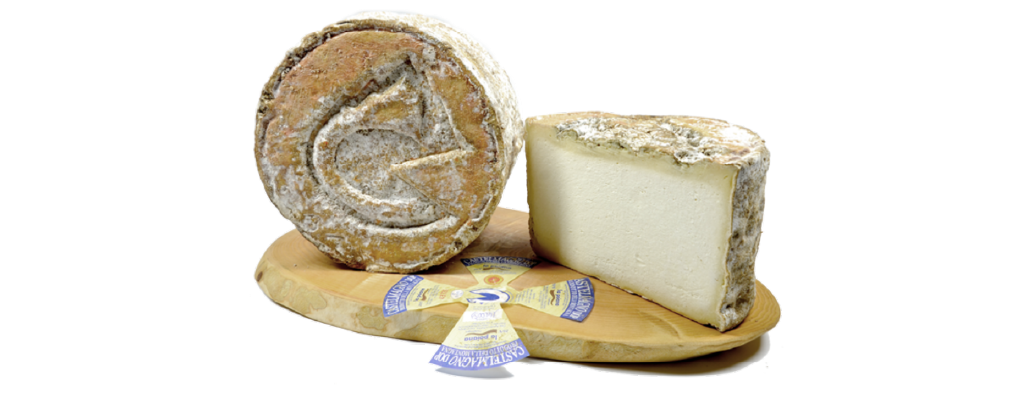
Cevrin di Coazze
I tasted this cheese for the first time during a “study trip”–as we used to call them–with my university classmates. As a cohort of 25 students plus a tutor, we had to split into two groups to make the steep ascent to the mountain cottage in Val Sangone, where Cevrin di Coazze is traditionally produced. Half of us opted for the van, while the other, more adventurous half–and I remember being completely overdressed for the task–hopped onto the trailer pulled by the shepherd’s tractor, and up we went, holding on tight as the road grew bumpier and twistier. When we finally reached the summit, a generous merenda had been prepared as a reward for the trek: a dozen sliced rounds of Cevrin, grissini, and wine were spread out on a picnic table. The sun was setting over the Alps. It was July, and the air was fresh. It was as close to perfection as it gets.
The first bite was revelatory: it was unmistakably goat’s cheese, but it tasted nothing like the goat’s cheese we typically encounter. The crumb was sharp yet sweet, semi-hard but yielding, too. I asked how that was possible. The producer explained that it was because the cheese wasn’t made solely from goat’s milk from the Alpine Chamois breed–despite the name Cevrin, which literally means “goat”–but also from cow’s milk, which was added in varying proportions depending on the season. The higher the percentage of goat’s milk, the sharper and more layered the flavor, reflecting the diverse flora of the mountain terrain that the animals grazed on during the season. The texture, meanwhile, was shaped by both the making and aging process–Cevrin being a cave-aged cheese, matured for about three months to develop an earthy character and a recognizable reddish natural rind to round it all out.
Produced in small quantities by artisanal cheese makers like the ones we encountered, who practice transhumance during the summer months, Cevrin di Coazze is deeply rooted in the local traditions of Val Sangone, a region with a pastoral vocation. For this reason, it is also recognised as a Slow Food Presidium. Just as we enjoyed it with abandon at that spontaneous picnic–I ate so much I felt dizzy–Cevrin di Coazze is often savored as a table cheese au naturel, so as to appreciate its unique flavors without any interference.
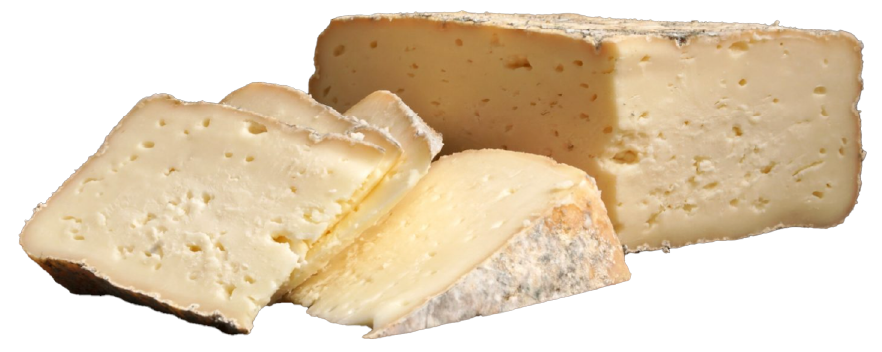
Robiola di Roccaverano
I love a good alliteration as much as I love a creamy, rich, tangy, raw milk cheese–and Robiola di Roccaverano is the best of both worlds. The origins of this cheese can be traced back to the era of Celts, who used to breed goats in the area. But beyond that, its style is the living evidence of the deep bond between Piedmont and France, even though Robiola is made with the distinctively Italian custom of resourcefully mixing whatever milk is available. A DOP product (the only robiola-type cheese to hold this status), it’s crafted from goat milk (at least half of the total), along with varying amounts of sheep’s and cow’s milk, during the warmer months from April to October, with animals grazing freely on the lush flora of the rolling hills in Asti and Alessandria. The designation of origin not only protects the cheese’s geographical authenticity but also mandates specific traditional practices in its production, ensuring it embodies the biodiversity of its native terroir. The variations in the types of milk, along with the grazing season, are key to its one-of-a-kind, sweet-and-piquant, fresh flavor.
So, what kind of cheese is it, exactly? Ah, where to begin. Robiola di Roccaverano is a soft-ripened cheese with a compact yet spreadable interior and a creamy layer just under the natural, pale, edible, wrinkly rind. Its flavor profile is mild and milky when fresh (it’s released at a minimum of four days old), with grassy notes that intensify as it matures, picking up hints of earthiness and mushrooms. Whether young or aged, I wouldn’t bother cooking with it–enjoy it in generous slices on top of the best bread you can find (it’s fantastic with pears, too) and pair it with a glass of lively Timorasso.
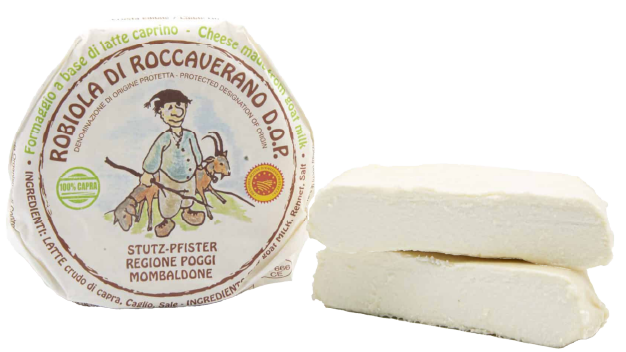
Montebore
An ideal wedding cake alternative for anyone who isn’t particularly fond of sponge and cream. If you don’t believe me, consider this: even Isabella of Aragon and Gian Galeazzo Sforza served it at their wedding banquet in 1489–a particular moment of esteem for this cheese.
Jokes aside, Montebore does look like a miniature, multi-tiered naked cake. When aged, it even develops a slight pinkish hue on the outside. Instantly recognisable yet rare, Montebore hails from a small village of the same name in the province of Alessandria. It has a long history dating back to post-Medieval times, its origins rooted in the rural communities of the Apennine hills. By the 1980s, however, Montebore was on the brink of extinction due to a decline in traditional cheesemaking practices and rural depopulation. Thanks to local efforts and Slow Food’s recognition, it has recently seen a revival.
Much like the aforementioned Robiola and Castelmagno, Montebore is made from a blend of milks–most commonly cow’s and sheep’s, with a slightly higher proportion of cow’s milk, though some variations include goat’s milk as well, depending on traditional practices and the season. Also, depending on the aging process, it ranges from semi-soft to firm, developing a natural, pale-yellow rind with a hint of pink. The flavor is creamy, mild, and subtly tangy when young, but becomes more robust, nutty, and slightly spicy as it matures. The longer it’s aged–and it can mature far longer than one might expect–the more intense its flavor becomes. I like mine semi-hard, with a fragrant rind that doesn’t give out notes of ammonia, served with crackers and a pallid red wine like Pelaverga to round out a meal.
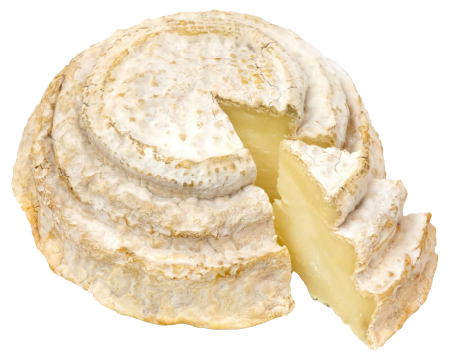
Seirass del fen
Picture the richest aged ricotta you can imagine, wrapped in a picturesque layer of hay (fen in the Piedmontese dialect), and you have Seirass del fen–an Alpine ricotta-style cheese from the Alps of Cuneo. Before we continue, a word on ricotta, which has undergone an identity crisis as people began to refer to their homemade cheese curds by this name. Ricotta is not curdled milk; it is made with whey after the primary cheesemaking process has taken place. The whey is reheated (hence the name ricotta, meaning “recooked”), and any particles that emerge and stick together are gently ladled into molds and drained.
Seirass is primarily made from whey, specifically from a combination of cow’s, goat’s, and sometimes sheep’s milk whey (see a theme here?), with cow’s milk being the main component. However, unlike standard ricotta–and just to make things a bit more exciting–Seirass may also include a small amount of milk, giving it a creamier texture.
The cheese has a softly granulose texture, and its flavor is mild, fresh, and slightly tangy, with subtle herbal and floral notes imparted by the natural Alpine hay. The practice of wrapping Seirass del fen in hay is said to date back to the early 1900s, when a merchant from Cuneo named Tistot D’Franca came across a fine, aged ricotta cheese that was unfortunately unsuitable for transport. After deciding to purchase a batch, he wrapped it in hay as a means of protection, and upon its arrival, he discovered not only that the hay had acted as a natural packaging, but that it had enhanced its grassy notes. Seirass producers picked up on this habit and continued to wrap fresh Seirass in hay to transport it from mountain to valley, imparting a distinctive flavor from the wildflowers and herbs of the alpine meadows.
Seirass del fen is often enjoyed fresh, more frequently as an antipasto than as a pre-dessert. Its creaminess and delicate nature also makes it a versatile choice in cooking, particularly–in my case, a true soft spot and something I always order in local restaurants–in stuffed ravioli.
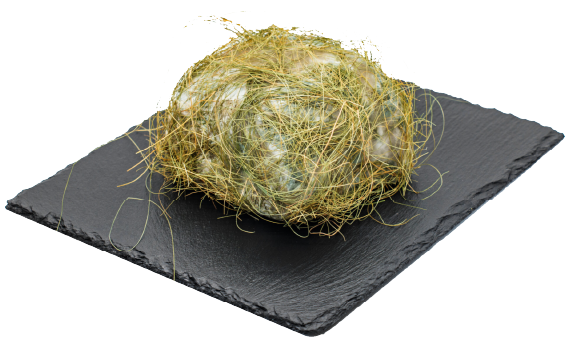
I could go on forever, but for brevity’s sake, let’s wrap this up. But first, a last round-up of other cheeses worth your attention and great for everyday enjoyment:
Raschera is simple, yet complicated. Its alpine variant is recognised as a Slow Food Presidium, which differs from the DOP-certified version produced exclusively in the municipalities of Frabosa (Soprana and Sottana) and Ormea, where an annual festival is held in its honor. Other areas of production include Montalto di Mondovì, Roccaforte di Mondovì, Roburent, Pamparato, Garessio, and Magliano Alpi. Then, there is another, less prized version of Raschera produced throughout the province of Cuneo, which is what one typically finds in supermarkets. Mild and slightly fruity, Raschera is at its best–Aunt Paola knows this well–when grated, melted, and used to season pasta, gnocchi, or vegetable flans. I’d save the alpine version for an end-of-the-meal treat.
Bra (cue the laughter) is another protected cheese, produced in both hard and soft forms in the town of Bra (yes, really), also in the province of Cuneo. It’s an icon, widely available, and a perfectly democratic ambassador of the region’s cheesemaking traditions. Bra tenero (the soft kind) is mild, gently fruity and my go-to for simple sandwiches and picnics, while the nutty, sweet-spicy Bra duro (the aged kind) is a great, uncomplicated cheese for nibbling and holds up well on a cheese board.
Toma, a name that has come to mean both everything and nothing, refers to many varieties with differing milk compositions and aging processes. Macagn is a type of Toma (an amazing one, really–it has a pineapple undertone that I find extraordinary); so is Toma di Pecora di Murazzano (a special cheese produced in the Langhe hills from the milk of an endangered local sheep breed). And then there are tomini, completely different (little) bloomy-rind beasts. Either way, if you come across a Toma, it’s likely from Piedmont, and while many may not be mind-blowing (with exceptions for the few mentioned here), they’ll be good and serve as a solid, crowd-pleasing, and versatile addition to your cheese selection.


